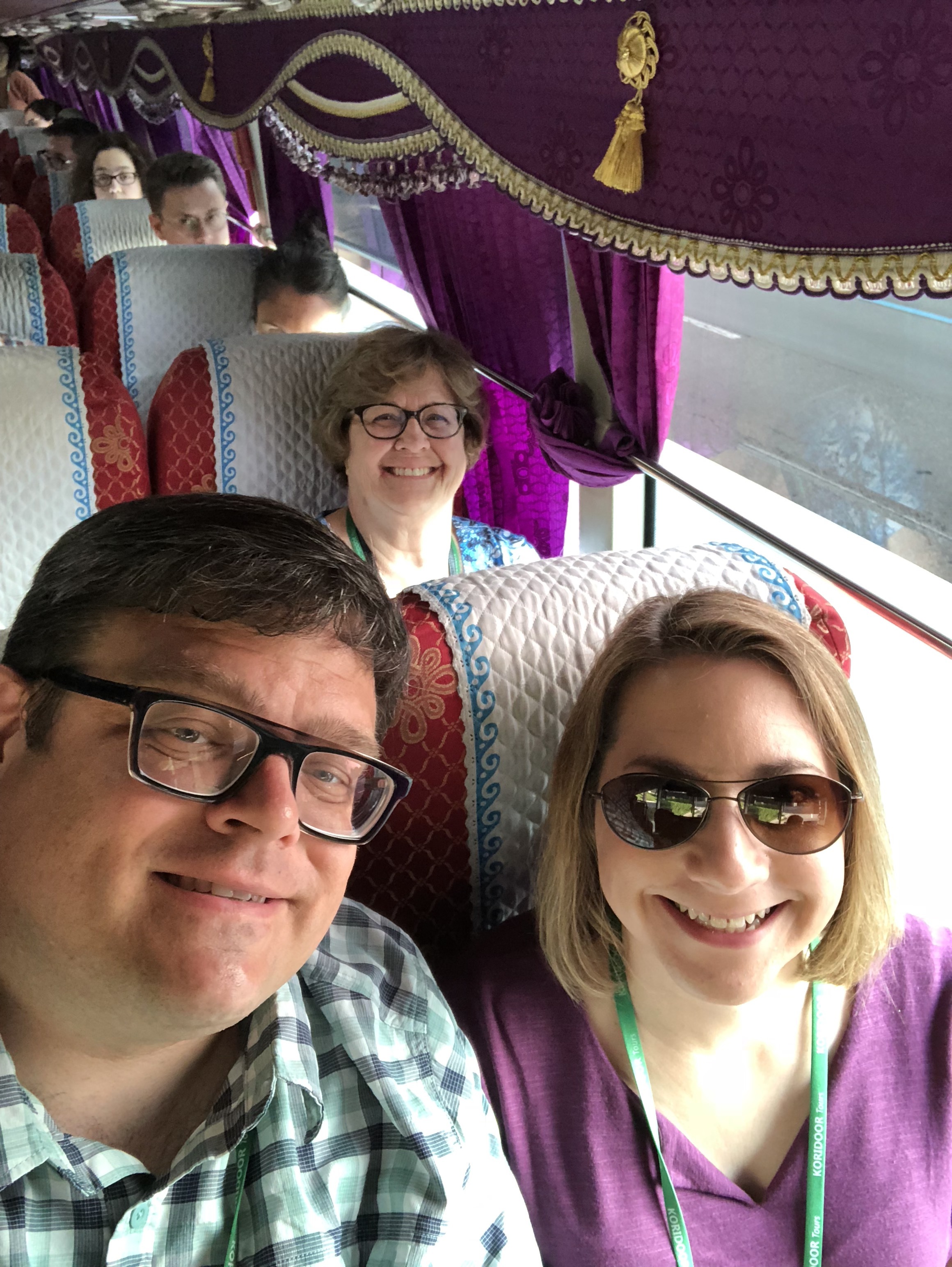Travel North of the 38th parallel? Our trip to the DMZ.
—Amy M. Gardner
I’ve read many books by people who’ve left North Korea, so I was really excited by the prospect of being able to visit the DMZ while we were in Seoul. It was one of the highlights of our time in Seoul, so we wanted to share a few tips for others who might be considering visiting. First, a little background.
There is more to visiting the DMZ than visiting the conference rooms you’ve seen 10,000 times on TV – the DMZ is the term that refers to the entire demilitarized zone that divides the Korean peninsula between North and South Korea. The DMZ is in fact about 160 miles long and 2.5 miles wide.
The Joint Security Area, or JSA, is the area within the DMZ that’s usually shown on TV when the DMZ or North and South Korea relations are discussed – it’s the area near the western end of the DMZ where small blue buildings are located and where meetings and negotiations can take place. (It’s where North Korean leader Kim Jong Un and South Korean President Moon Jae-in met in May.
Our tour departed Seoul at 7:30 a.m. and arrived at Camp BONIFAS about an hour and a half later. We (like other groups going to the JSA) had a briefing by a representative of the US military at the JSA Visitor Center. From there, our group went to the JSA and visited first the Freedom House (no pictures allowed but it was built by South Korea to house Red Cross staff and host reunions (that didn’t happen) of families separated by the border) the conference room (where you can have your photo taken with a South Korean guard technically standing in North Korea – you are told if you open the door and cross into North Korea outside the room, you are on your own), the Bridge of No Return, and the Third Infiltration Tunnel. We also visited the Dora Observatory (where you can see into North Korea) and the Dorasan Train Station, a restored station on the (now dormant) line between North Korea and South Korea. (Several trains each day go from Seoul to the Dorasan stop.) Visiting the platform at the train station is an extra 1,000 Korean Won, or 89¢ US.
To me, the JSA and seeing into North Korea were the highlights of the trip. Standing at the Dora Observatory watching a North Korean man bicycling along a road was something I won’t soon forget; while there is so much on the news about North Korea, here was a man just pedaling along through the countryside, likely not even aware that dozens of tourists were watching through binoculars and imagining what his life is like.
Here are a few tips if you’d like to plan your own excursion to the DMZ:
(1) Pick the sights you’d like to see. Different tours go different places, so figuring out the things you want to see is important before selecting a tour.
(2) Decide between a half day and full day tour. Personally, by the time you are in the bus for roughly an hour plus each way, I’d have hated to miss out on the JSA (the part most half day tours cut) to save a couple of hours out of our trip.
(3) Make sure you pack clothing that meets the dress code. North Korea allegedly takes photos of people visiting the DMZ from the South Korea side and creates propaganda claiming that people in the South are poor, which is why you are required to wear clothing that meets a dress code in order to visit the JSA. Specifically, we were told we could wear only closed-toe shoes and no sleeveless shirts or those exposing your stomach; no clothing with “insulting, profane, provoc[ative] or demanding representations;” no ripped jeans; no shorts or skirts shorter than knee length; no sheer or stretch clothing (so no leggings); no sports uniforms, logos, or athletic clothing; nothing with camouflage; nothing oversized or excessively baggy; no “leather ‘biker’ vests and leather riding chaps.” All that said, I saw several people who were told by another company that they didn’t need to change out of their shorts into the pants they had brought. I don’t know if that was because of the record-setting heatwave, because no North Korean soldiers were visible from the other side, or if that other company was just lax that day. There were people in our group, though, who hadn’t packed clothing that met the dress code and had to buy it in Seoul, so plan ahead. (A few people in our group wore pants with legs that zipped off into shorts. Maybe not the most stylish option, but it seemed pretty genius in the heat!)
(4) Book well in advance. The tours do fill up, and your passport and other information has to be provided in advance in order for you to be able to go to the DMZ, so do plan ahead at least a week or so. (Longer if you have your heart set on a specific tour or have limited days when you can fit it into your schedule.)
(5) Make sure you plan ahead for what you need to take on the tour, such as your passport, tour confirmation, water, and a snack. (Some people in our tour did bring their own lunch, but the lunch at the cafeteria our tour took us to was very good and reasonably priced – less than $10 per person, depending on which entrée you picked as the bus was leaving Seoul.) Take packets of Kleenex because, as you’ll likely find in other places in Korea, the bathrooms in the DMZ did not always have paper.
(6) Get to the tour check in early. Our company told us we could load the bus about 30 minutes after we were actually able to board, so people who showed up “on time” ended up in the back of the bus. The seats on the left side seemed to have the best views.
(7) Take some cash for souvenirs, water, lunch, and additional stops if your tour goes to the train platform.
(8) If you go on a tour that visits an infiltration tunnel, be ready to walk down and back up a long, steep, and slippery (due to humidity) walkway.
We booked the full-day tour through Koridoor Tours for about $95 US per person. As I mentioned in our summary of tips for Seoul, the guide was sometimes hard to understand because of how quickly she spoke and I would have preferred if the bus driver wasn’t on his phone the entire day. Those are minor compared to the advantages: the tour ran on time, we got to see everything promised (not always the case due to circumstances outside their control), everything was well-organized, and the tone was more matter-of-fact than overly dramatized, as I have heard is sometimes the case with other companies.
The DMZ tour was absolutely worth the time and expense. I appreciated the chance to get to visit the DMZ and JSA (and to legally enter North Korea, even without a passport stamp!), and definitely recommend it to anyone interested in learning more about this area that is important both historically and today. If you do go, I highly recommend reading up on North Korea in advance – the reading I had done made it a richer experience.
Have you been to the DMZ? Would you visit North Korea?
End of the line. Dorasan Station. If rail access is restored through North Korea, travel would be possible from Seoul all the way to Lisbon.




